23 February 2009
Hotel Lawyers find a ray of sunshine. As the headlines continue to belt out new tales of financial crises, crumbling infrastructure and staggering debt, it’s nice to have an occasional ray of sunshine. Here it is, from Italy!
As regular readers of www.HotelLawBlog.com know, a few times a year, we depart from our usual format to talk about interesting or historic events uncovered in our travels. For example, many readers still comment on the article Where does the word “spa” come from? and of course, just last fall, we had Lessons from History: When will we ever learn?
A special visit to Tuscany — Florence and Montalcino
But this time, Lana and I are on a brief vacation in Tuscany, Italy. Our goals were to spend some focused time visiting Florence and Montalcino. Florence, of course, is one of the most important birthplaces of the Renaissance, and Montalcino is the home of Brunello and a 4-day event each February to welcome the release of the latest vintage of Brunello (this year the 2004s).
The executive summary in one sentence is this: Tuscany in February is great. And the 2004 Brunellos that were just released are fantastic!
If you would like to escape the depressing financial news for a few moments, read on . . .
Italy in February?
In the middle of February, Tuscany is a little cold (ranging from overnight temperatures in the 30s to day time highs in the mid-40s). Nonetheless, going to Italy at this time of year is a little like going to the beach on a rainy day. There are no crowds, no lines, and you can find space anywhere you want.
No lines at any museums, restaurants or historical sites. No crowds.
But it was even better in Italy (than the rainy beach). All the great people, trattorias, art, museums, historic pallazzos and beautiful countryside are there. Except for one day, the weather was sunny and dry (just cold) — but there were no crowds or lines anywhere.
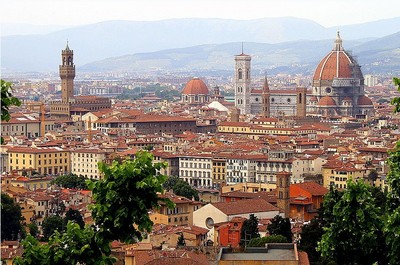
Florence is the modern capital of the region called Tuscany. It was established by Julius Caesar in 59 BC, but rose to great prominence in the Middle Ages as the “cradle of the Renaissance.” It was particularly noted for its art, architecture, and literature with such greats as Donatello, Michelangelo, Leonardo da Vinci, Dante, Brunelleschi. This skyline shot of Florence shows the famous Duomo toward the right and the unique tower of the Pallazzo Vecchia on the left.
Welcoming the 2004 Brunellos. A five star rating.
After a few wonderful days in Florence, we moved on to Montalcino, a charming town with medieval roots, and they are renowned for Brunello wine.
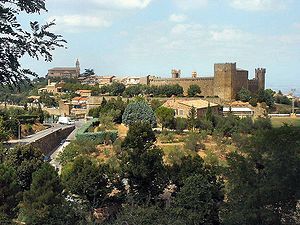 Montalcino is a hilltop village probably settled by the Etruscans, probably had an abbey in the early 9th century, and grew significantly in the 10th century. The town name comes from a variety of oak tree that flourished in this area.
Montalcino is a hilltop village probably settled by the Etruscans, probably had an abbey in the early 9th century, and grew significantly in the 10th century. The town name comes from a variety of oak tree that flourished in this area.
The first medieval walls were built in the 13th century. The fortress which dominates this photo was built at the highest point of the town in 1361.
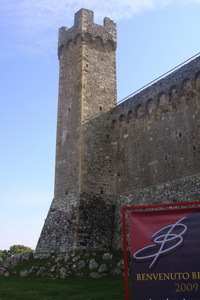
This is a closer shot of the fortress or “La Fortezza di Montalcino” which serves as the site of the annual “Benvenuto Brunello” or literally “Welcome Brunello.” The “Benvenuto”, as it is called, is the annual welcoming by local Montialcinisi and wine enthusiasts around the world of the new release of Brunello, one of God’s great gifts of wine to mankind.
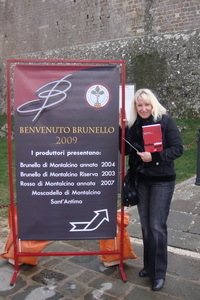
We arrived in Montalcino in time for the 2009 edition of the Benvenuto Brunello which officially debuted on February 20 and 21.
According to the Brunello Consortium president, the 2004 vintage is acclaimed with a five star rating — one of the best of recent vintages.
Wines featured at this years Benvenuto were the Brunello (2004, Rosso di Montalcino 2007 and the Brunello Riserva 2003s (the Riservas are released one year after the regular Brunellos).
Approximately 146 producers were represented at Benvenuto Brunello 2009, while more than half of the now 250 odd producers. That is quite an expansion from the original nine producers, and their history is also very interesting to me.
The history of Brunello — old roots with a recent denomination
In the 12th century, or even earlier, Italy developed a feudal farming system that persisted until the 1960s. It was essentially a sharecropping arrangement under which the “contadino” farmed the land for the aristocratic owner or “padrone.” Under this system, the contadinos never got out of debt and often found themselves struggling to pay off the debt of their forebears.
Finally, in the 1960s, there was a land reform which enabled a small number of the contadinos to buy their land. Over the next few years, these farmers gradually found that they could make more money growing grapes than potatoes and ultimately, they became producers of the marvelous wines we call Brunello, but not until winning a bitter fight with the aristocrats who tried to say that the Brunello appellation should be applied to wines produced by the aristocratic families as opposed to wines produced from grapes grown in a specific geographic area.
Ultimately, with the support of Dotorre Bruno Ciatti, a scientist with ministry for agriculture in Montalcino, rules were forged in 1965-66 to define the Brunello designation, leading the establishment of the 1968 Consorzio del Vino Brunello. It determined that it was only the location of the land and not the blood of the owners that would determine if a wine could be called “Brunello.”
I am told that initially, there were only 9 estates producing Brunello, but today there are approximately 250 producers, many of them very small.
A few thanks and credits
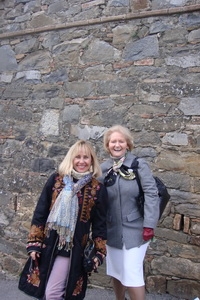 Lana and I want to thank our friend, Marilyn and Corky Severson, who gave us so many great suggestions for the trip, ranging from restaurants to the importance of attending the Benvenuto in the first few days, and for their hospitality at the incredible restored villa that they partnered on with the Ferragamo family — Castiglion del Bosco.
Lana and I want to thank our friend, Marilyn and Corky Severson, who gave us so many great suggestions for the trip, ranging from restaurants to the importance of attending the Benvenuto in the first few days, and for their hospitality at the incredible restored villa that they partnered on with the Ferragamo family — Castiglion del Bosco.
Marilyn (on the left in the photo) also recommended two great books on Montalcino by Isabella Dusi (on the right in the photo): Vanilla Beans & Brodo (Real Life in the Hills of Tuscany) and Bella Vino. We also had the pleasure of meeting her for lunch before we left.
These books give great insights on what life is really like in Tuscany, and how many of the customs and practices have evolved.
Now we can go back to the Gloom and Doom, knowing there is a refuge in Tuscany and in the great 2004 Brunellos!
This is Jim Butler, author of www.HotelLawBlog.com and hotel lawyer, signing off. We’ve done more than $87 billion of hotel transactions and more than 100 hotel mixed-used deals in the last 5 years alone. Who’s your hotel lawyer?
________________________
Our Perspective. We represent developers, owners and lenders. We have helped our clients as business and legal advisors on more than $125 billion of hotel transactions, involving more than 4,700 properties all over the world. For more information, please contact Jim Butler at jbutler@jmbm.com or 310.201.3526.
Jim Butler is one of the top hospitality attorneys in the world. GOOGLE “hotel lawyer” or “hotel mixed-use” or “condo hotel lawyer” and you will see why.
Jim devotes 100% of his practice to hospitality, representing hotel owners, developers and lenders. Jim leads JMBM’s Global Hospitality Group® — a team of 50 seasoned professionals with more than $87 billion of hotel transactional experience, involving more than 3,900 properties located around the globe. In the last 5 years alone, Jim and his team have assisted clients with more than 100 hotel mixed-use projects — frequently integrated with energizing lifestyle elements.
Jim and his team are more than “just” great hotel lawyers. They are also hospitality consultants and business advisors. They are deal makers. They can help find the right operator or capital provider. They know who to call and how to reach them.
Contact him at jbutler@jmbm.com or 310.201.3526. For his views on current industry issues, visit www.HotelLawBlog.com.



